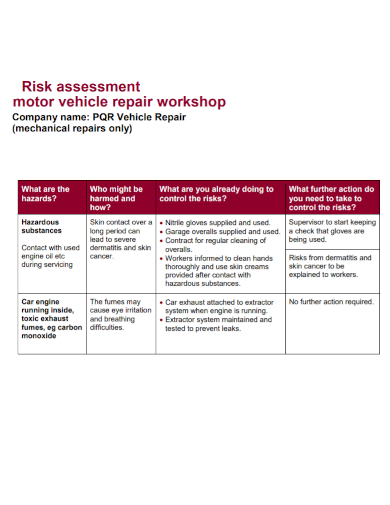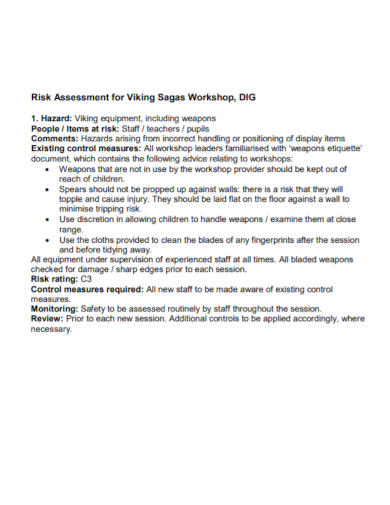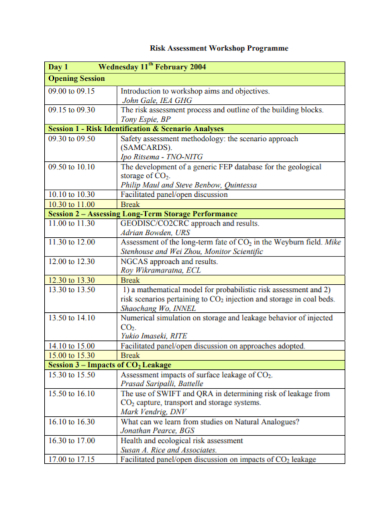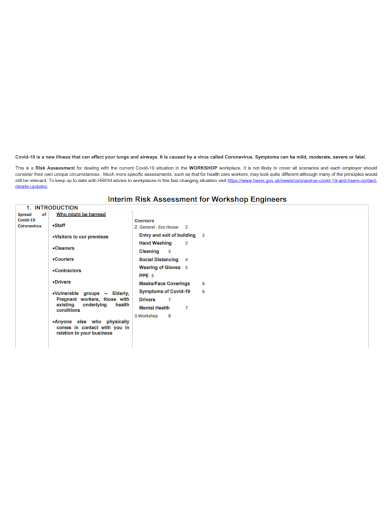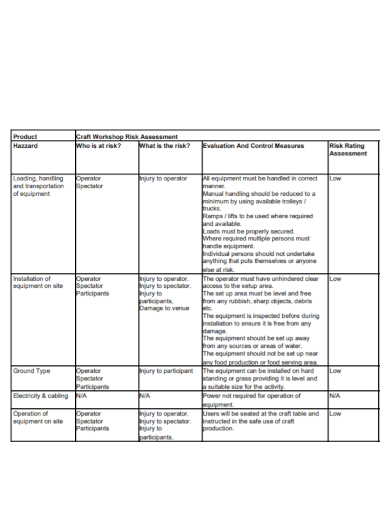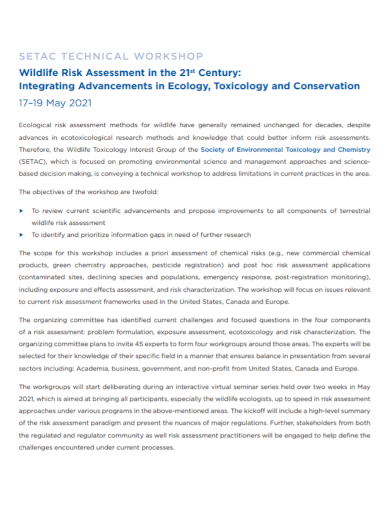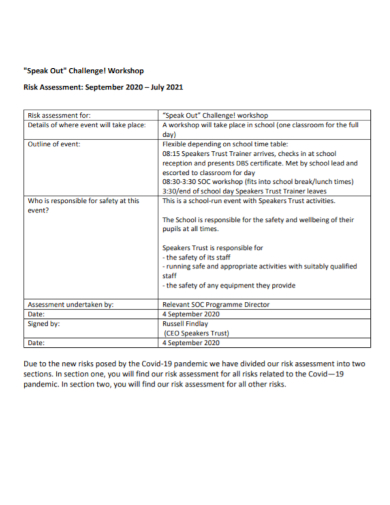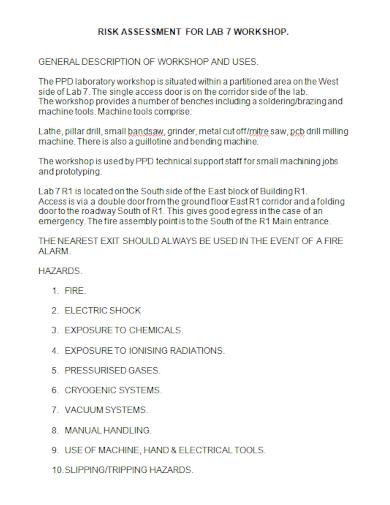Working in industries that require manual labor are usually faced with more safety risks and hazards compared to office work. Dealing with machines, equipment, tools, harmful substances can be dangerous but the dangers can be be prevented if there is proper risk assessment and safety protocol set in workshops. Read the article to know how to conduct a risk assessment in workshops.
10+ Workshop Risk Assessment Samples
1. Motor Vehicle Workshop Risk Assessment
2. Workshop Operations Risk Assessment
3. Workshop Covid-19 Risk Assessment
4. Workshop Hazard Risk Assessment
5. Workshop Programme Risk Assessment
6. Workshop Engineers Risk Assessment
7. Workshop Product Risk Assessment
8. Technical Workshop Risk Assessment
9. Workshop Event Risk Assessment
10. Workshop Activity Risk Assessment
11. Lab Workshop Risk Assessment
What is Risk Assessment?
Risk assessment is the process of evaluating the safety risks of the workers in the workplace and establishing protective measures that would help control and eliminate those risks. By having those risks controlled, the production and operations in your workshop are less likely to get interrupted costing you time and money.
How to Do a Workshop Risk Assessment
1. Identify the Hazards
Evaluate all the activities and operations inside and outside of the workshop. Identify every potential hazard that could lead to an accident or incident occur and take note of it. This will help you decide what safety protocols you can create or how you can update your existing protocol.
2. Know the People Who Are at Risk
Next is to determine which workers are exposed to hazards and safety risks. Come up with ways on how they can be protected from these hazards. You can include this in your safety protocol.
3. Assess the Risks
Evaluate next the risks that come with your day-to-day operations and how likely these operations might cause potential harm to the workers. Review any past incidents or accidents that occurred, and the corrective action plan that was done to address and improve the operations. To effectively evaluate the risks in the warehouse operations, categorize each risk on the severity of the hazard: high, medium, or low.
4. Record Your Observations
After evaluating the risks, observe the warehouse operations in real-time and record your observations. Make sure your observation report is detailed and clear because the information in it will be useful for the next step.
5. Update Your Current Protocols
From your risk evaluation and observation report, apply that information to update your safety protocol. Implement the changes by training your staff with health and safety training and changing some processes of your machine operations to lessen the risks from happening.
Risks That Are Likely Happen to in Workshops
- Electrical Accident: This unfortunate incident is usually common in the workplace. They are caused by unprotected exposure to high voltage electrical outlets. Electrical burns, electrical fires, and electrical shocks are the most common types of electrical accidents.
- Exposure to Dangerous Chemicals: Toxic chemicals in the workplace can also jeopardize the safety and health of employees; especially when they are exposed to these substances without appropriate caution, proper equipment to handle it, and if they are not stored properly.
- Machinery and Tools Hazard: Employees are at risk of machinery and tools accidents, especially if they don’t know how to handle it properly or if they weren’t mindful of the equipment.
- Workplace Harassment: It might not be a very obvious problem, but it is alarming and hazardous to the productivity and the safety of the working environment. With tension between employees regarding toxic behavior like threaten, abuse, ridicule, or discriminate employees can lead to ugly brawls or confrontations and can have adverse effects on work performance.
- Fire Accidents: A grave danger that can result in the loss of life and property in the workplace.
- Workplace Theft: This risk might fly under the radar since it might not be obvious until it’s too late. When an employee illegally obtains cash or other properties from the workshop can affect the trust and confidence of employees with each other leading to tension. It could also affect the budget and cost of the workshop.
FAQs
What are the general safety rules?
Here are some general safety rules that all people in workplaces should follow:
- Keep your work areas clean
- Always use the proper tool for the job
- Never work on live equipment or machine
- Stop the work when it is needed to address hazards
How to reduce hazards in your workshops?
To reduce any risks of hazards in your workshops, all workers must
- Practice good housekeeping
- Use correct labeling on all tools, equipment, and chemicals
- Protect themselves from operating machinery
- Follow the findings of the risk assessment
- Report any problems
- Wear protective personal equipment (PPE) always inside the workshop
Review your updated protocols at fixed intervals to ensure that the agreed safe working practices continue to be applied and followed by every worker. If there is any new machinery or a new process to work on and include in your daily operations, you can effectively assess its risks more effectively. To help you get started on doing your own assessment, download our free sample templates above to use as your reference!
Related Posts
FREE 10+ Teleworker Self-Assessment Samples in PDF | DOC
FREE 10+ Market Assessment Samples in PDF | MS Word
FREE 10+ Quality Risk Assessment Samples [ Control, Assurance, Management ]
FREE 6+ Immediate Termination of Lease Agreement Samples in MS Word | Google Docs | Apple Pages | PDF
FREE 10+ Qualitative Risk Assessment Samples in PDF | DOC
FREE 10+ Comprehensive Needs Assessment Samples in PDF
FREE 10+ Evaluation Quality Assessment Samples [ Self, Loss, Data ]
FREE 10+ Promotion Assessment Samples [ Health, Self, Employee ]
FREE 10+ Environmental Impact Assessment Samples in PDF | DOC
FREE 10+ Employee Competency Assessment Samples in PDF | DOC
FREE 10+ Safety Assessment Samples [ Home, Health, Risk ]
FREE 10+ Change Impact Assessment Samples [ Management, Control, Request ]
FREE 10+ Qualitative Assessment Samples in PDF | DOC
FREE 10+ Staff Assessment Samples [ Workplace, Health, Risk ]
FREE 10+ Vulnerability Assessment Samples [ Security, Network, Risk ]

